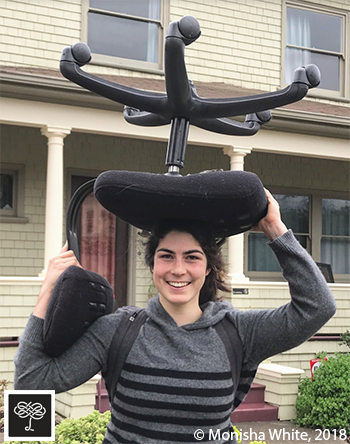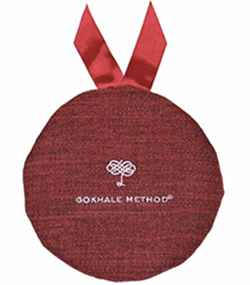4 Benefits of Carrying on the Head
Carrying weight on the head is a primal activity, something we have done for millions of years.

Transporting water in the Ouahigouya marketplace, Burkina Faso, 1998.
I took an archeology course at Stanford from professor John Rick that included a workshop on stone knapping (chipping away at a stone to create arrowheads and similar tools). While most of us created pitiful arrowheads with no chance of any hunting success, a few members of the class hit the obsidian at productive angles that resulted in decent weapons. Professor Rick says that about 10 percent of his students intuitively know how to make good arrowheads. He believes that the relevant DNA for being good at this task has been conserved through the generations in these individuals. Making stone tools like arrowheads was essential in our past, with the “tool kit” remaining unchanged for a surprisingly long period of a million years in the archaeological record. Given this length of time, and the utility of being able to create good arrowheads, it makes sense that this ability would have been naturally selected for. For most societies, It’s been quite a long time since we needed this ability, and most of us have lost the genetic traits that support making good arrowheads, but it seems that in a small percentage of us, the relevant code persists.
I believe a similar situation holds true for carrying on the head. People have carried on their head for a very long period of time, and have continued to do so until very recently (it’s still important in some areas of the world.) My experience with students is that for almost everyone, a small weight on the head acts as a cue for neck and back stabilizer muscles to engage. This protects the spine from compression. It is striking that this complex muscular response is intact even when we have gone our whole lives without the signal-response being activated.

Gokhale Method teacher Monisha White modeling carrying on her head
Benefits of carrying weight on your head:
1. Helps you find your axis
Locating the spot on the crown of the head is easy (see video on this page), and once you apply a weight there, you have a very visceral sensation of your vertical axis. The weight acts as a stimulus to line up the relevant bones / joints; misalignment is suddenly very palpable as your muscles work harder than you are used to against the weight. If your head has drifted forward, your neck muscles are dealing with a lot of torque, which is inefficient and feels tiring; the body naturally corrects to be most efficient.

Carrying significant weight on the head necessitates lining up your bones and joints well.
2. Strengthens your longus colli muscles in the neck
When you apply a weight on the head, it serves as a cue to engage your stabilizer muscles. The weight strengthens your longus colli muscle (deep in the neck) as well as your inner corset muscles throughout the torso. These help brace the body, like a column, under the weight. These are the muscles that support and brace your spinal column to prevent compression during physical activities, so strengthening them will make you more resistant to wear and tear as well as injury.

This young Burkina mom keeps herself strong with all that she carries.
3. Helps relax your superficial neck muscles
We tend to overuse our superficial neck muscles, especially the levator scapulae, scalene, sternocleidomastoid, splenius, and trapezius muscles. When the stabilizer muscles are cued to take back their responsibility for supporting the head and neck, the more superficial muscles of the neck can relax better.

Carrying weight on the top of your head helps activate deep neck stabilizer muscles and is surprisingly relaxing for superficial neck muscles like the scalenes.
4. Evokes a feeling of groundedness
Perhaps because of the primal nature of carrying weight on the head, I have heard from and seen in many students, and experienced myself, that placing a weight on the head has a centering and grounding effect. The feeling seems to help the mind remain engaged and present with the physical, and is quite calming. Much like meditation, it helps quiet overthinking and background noise in the mind, and creates a space to focus just on the sensations in the body.

Once you’ve built up the proper muscles, you can carry larger objects.
I used to use a folded sweatshirt or blanket to practice, but got tired of sleeves working their way down in front of my eyes and such. Eye pillows don’t center the weight on the crown of the head very well. In 2014, I designed the Gokhale head cushion for more practical extended use. We experimented so it has a useful weight, coefficient of friction (it can fall off the head but not too easily), and hardiness (moisture won’t ruin it). I’ve taken to placing several of them around my home to work as reminders to carry it on my head off and on. I floss my teeth while donning the head cushion in my bathroom; I begin my emails with the head cushion near the communal desk. I’m planning a walk to the Stanford dish with a cushion, now that my neck is getting stronger.

The Gokhale head cushion was born in 2014 and helps thousands of people find a healthy axis in their necks and bodies
Do you ever wear any weight on your head? How do you remind yourself to do this practice? What object do you use?

Comments
When I was in Cairo, Egypt I
When I was in Cairo, Egypt I saw a man carrying a very large tray of bread on his head. One hand supported the tray, and one hand was steering the bicycle!
I grew up in west Africa, and
I grew up in west Africa, and women always carried loads on their heads. Men carried spears and machetes for defense. In a difficult situation (snakes, animals etc) the women would throw down the loads and the men fight. So I really do not think one can impute that women were necessarily low status and therefore carrying loads. Different work for different people.
We also carried things on our heads there, and it was very useful. As for the head cushion, many women twisted a length of cloth into a doughnut shape, and settled it on the head. It evened out the load, and protected the more pointy headed...
Good article!
I grew up in India and men
I grew up in India, and men and women continue to carry weights on their heads in that country. There are men who are fruit and vegetable vendors, porters at railway stations, construction workers, farmers - all of whom carry things on their heads. In villages women can spend a lot of time fetching water, sadly, and this is usually carried on the head, sometimes along with another pot on one hip. However with the exception of being a porter, there are women doing all the jobs I mentioned above for men. There is a clear class divide and you do not find middle class people using this traditional method of carrying things.
I'm new to trying to improve
I'm new to trying to improve my posture --- as in having begun seriously only a few days ago. I'm 68 and am going to need a lot of work to correct the bad habits of a lifetime. After reading this, I walked inside a few minutes with a large bean bag on my head. It's amazing to *feel* the difference in my posture just by placing something on my head. Thank you for your good work and excellent explanations.
Carla
This article helps me see
This article helps me see more advantages to walking with a weight on your head. I wonder if you
could put a weight on your head and then wear a beret or other hat on top of it. Then you could have
a weight on your head and look fashionable at the same time. Has anyone tried something like this?
Add New Comment
Login to add commment
Login